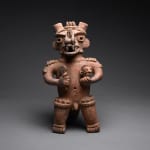Sculpture of a Standing Saurian Deity Holding a Club and a Head, 100 BCE - 500 CE
Terracotta
PF.3670
Further images
Large effigy vessels and standing figures portraying human beings costumed as alligators are a common theme in Ancient Costa Rica. They were probably used in rituals where the alligator image...
Large effigy vessels and standing figures portraying human beings costumed as alligators are a common theme in Ancient Costa Rica. They were probably used in rituals where the alligator image was important, as a symbol of power and dominion over the land. In the case of this beautiful figure the male depicted is a warrior seen carrying his trophy head in his left hand and a club in the right. On his shoulder are a series of pellets like a protective covering, as on the front part of his legs done in a checkerboard pattern. This protection seems ironic given the fact his genitals are exposed, and was meant to give visual proof of the warrior's courage and 'invulnerability'. Also, only the elite members of the warrior and chief classes were permitted to appear naked. The alligator mask, with scutes on the nose and top of the head, was probably modeled on ones actually worn, designed to make the hero seem mythical and more God-like than human. This figure expresses the values, religious beliefs, hierarchical structure and obsessions of a culture long vanished, wonderfully brought together in a work of art which alone has triumphed over all obstacles to remain intact and alive with mystery.









